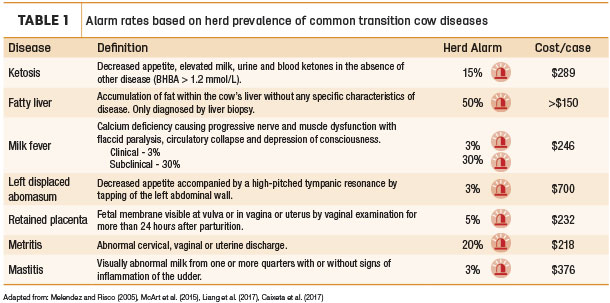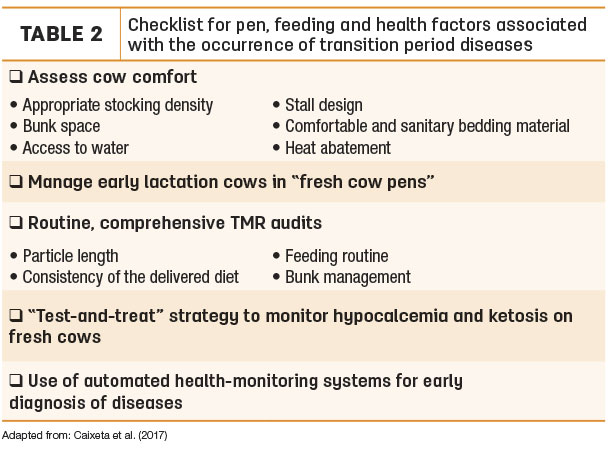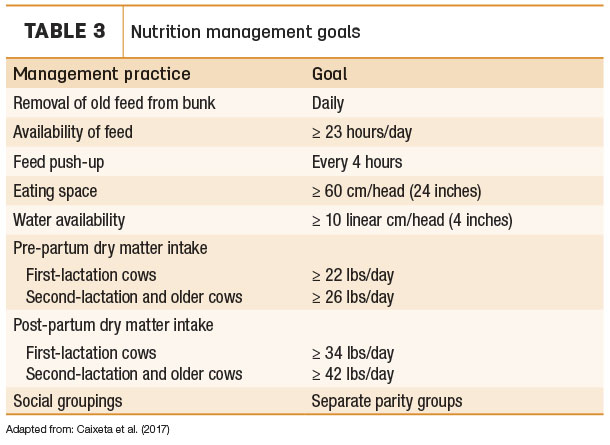Approximately half of the metabolic and infectious diseases affecting dairy cows are diagnosed during the transition period. One of the reasons for the increased incidence of diseases during the fresh period are the changes in their immune mechanism due to metabolic adaptations and negative nutrient balance due to milk production.
Caixeta stresses the importance of routinely monitoring dairy cows’ health and nutrition during the transition period. He identifies the following “herd alarms” to monitor for transition cow issues on your farm (Table 1).

“Reliable and effective data recording systems are paramount,” he says. There is a reciprocal relationship between the decrease availability of nutrients (energy and minerals) and disturbances in the immune system, he explains. The decrease of nutrients available affects the immune system; changes to the immune system affect the animals’ health. This exacerbates the nutrient imbalance, thus creating a feedback loop that can “further enhance health disorders, increase production losses and decrease the availability of safe and nutritious dairy foods for a growing global population.”
There are a number of factors that need to be monitored daily associated with the occurrence of disease during the transition period, including (Table 2):

Pen factors:
- Cow comfort
- Stocking density – 100 percent for far-off dry cows, 80 to 100 percent for close-up dry cows (depending on breed) and not more than 80 percent stocking density for fresh cows
- Bunk space – A minimum of 30 inches per cow of bunk space is recommended during the transition period.
- Access to water – at least two waterers in each pen area and a minimum of 4 inches perimeter linear space per cow in that area
- Stall design – Fresh cows need a clean, dry resting area, good footing to help with lying and rising, extra space to ease stress and easy observation of the rear of animals by handlers.
- Comfortable and sanitary bedding material – deep sand is an excellent choice
- Heat abatement
- “Fresh cow pens” for early lactation cows – Although fresh cows pens may appear the same as other pens, the major difference is they must have a lower stocking density than the rest of the farm to decrease stress; fresh pens are usually locked and observed on a daily basis to enable timely identification of sick animals.
Feeding factors:
- Routine comprehensive audits on total mixed ration
- Consistency of the delivered diet – daily particle length, similar feed composition and time of feed delivery
- Feeding routine adherence – Cows need to have a consistent ration in front of them 24 hours a day.
Health factors:
- “Test-and-treat” strategy – Use anionic salts during the dry period to minimize the occurrence of hypocalcemia and assess urine pH to monitor hyperketonemia on close-up cows.
- Automated health-monitoring systems for early diagnosis of diseases – Systems that use rumination and activity are promising tools for the identification of cows with metabolic and digestive disorders in dairy farms, but more research is needed to improve our understanding and use of the data generated by these systems.
Another issue that should be more closely observed is the connection between uncontrolled inflammation and cow health.
“Although more research is needed to evaluate the most common initiators of this inflammatory state, different lines of evidence suggest that signals derived from the uterus, mammary gland, gut and nervous system may all contribute.”

Though some degree of inflammation during this period is clearly important for normal function of the reproductive system and immunity, relevant work done by Dr. Barry Bradford at Kansas State University shows that a slightly elevated degree of inflammation can impair the entire lactation productivity of cows.
He notes that treatment of postpartum inflammation with nutrients or pharmaceutical agents is worth exploring as an industry, and such approaches must not disrupt the normal and necessary roles of inflammation postpartum.
“Defining and promoting a healthy degree of inflammation along with nutrient availability and cow comfort in transition cows may allow the dairy industry to limit transition disorders while improving productivity,” Caixeta says. ![]()
Kelli Kaderly-Boylen is a freelancer based in northeast Iowa.
Caixeta says to look for monitors on your farm that:
- Have minimum delay between cause and effect
- Show recent changes
- Detect variation
- Avoid bias
- Sensitively detect problems
- Specifically identify the problem





